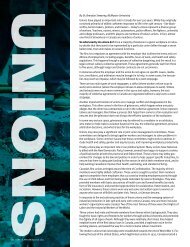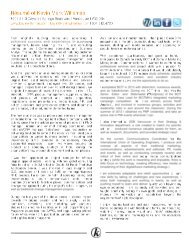OKANAGAN CRUSH PAD
You also want an ePaper? Increase the reach of your titles
YUMPU automatically turns print PDFs into web optimized ePapers that Google loves.
OCP’s vision revolves around passion, quality, and experimentation. They focus on supporting the industry rather than<br />
increasing their market share and volume. OCP’s marketing and brand message is clear; they do not wish to rapidly expand and<br />
compete with the established, larger Okanagan or national wineries. Embodiment of the Okanagan terroir flavor in their wines<br />
is paramount to them, as is nurturing startup winemakers and introducing innovative winemaking practices to produce exciting,<br />
high quality wines in exclusive batches. This approach presents numerous unique marketing challenges for OCP in their<br />
endeavors to establish themselves as a reputable player in the very competitive winemaking industry of the Okanagan and<br />
Canada (Wines of Canada, 2011) (Okanagan Crush Pad, 2012).<br />
Situational Analysis<br />
This section explores trends in the wine industry, providing analysis and insight into the market, consumer trends and<br />
behaviours, and the competitive landscape. Further analysis is provided to how these form both threats and opportunities for<br />
OCP, and their internal strengths and weaknesses.<br />
Industry Overview<br />
Market figures and wine consumption continue to grow globally, but Canadian figures outstrip those of the world average<br />
almost sixfold, with projections moving the country from fifth, to the world’s third largest wine consumer by 2014; surprisingly<br />
however, Canada is the only wine-producing country where imports exceed exports.<br />
On-trade companies, such as lounges and restaurants, have the most buying power as they distribute the majority (72.4%) of the<br />
wine market volume (MarketLine, 2012). This facilitates the market’s retail growth, as wine is becoming more popular<br />
compared to spirits and beer, and has surpassed spirits in terms of liquor store sales (Tuttle, 2012) (Nichols, 2011) (Canada<br />
Newswire, 2011).<br />
The Canadian government exercises strict control and taxing regulations over the domestic and international wine distribution.<br />
Many of the smaller wineries prefer (or are only able) to trade within their province. However, pressure from wineries and<br />
changing liquor board rulings may see these regulations changed in the very near future (OKCrushPad, 2011) (Klassen, 2012).<br />
Industry and Market Trends<br />
In British Columbia, wine consumption has remained relatively stable over the past five years, despite an almost 20 per cent<br />
rise in prices. More expensive, top-shelf wines are gaining ground, but table wines are still the most popular (Wine Market<br />
Council, 2011). Increased consumer spending is notable by customers purchasing more liquor in restaurants (Tuttle, 2012).<br />
In some ways, the industry is still catching up to the changing demands of new consumer markets. Wine is a highly<br />
differentiated product, with a variety of brands available in the market. Some wine producers have begun to improve brand<br />
management and modernize their merchandising by launching bold brand designs, “cheeky” labels, and integrated marketing<br />
campaigns in order to become more identifiable with the public. These factors have intensified rivalry between the brands,<br />
influencing wine drinkers to use the label designs and brand recognition as the only differentiating factors when choosing a<br />
bottle. This opposes traditional wine advertising, which focuses on the winery itself and its accolades, versus brand character<br />
and product benefits (Roberts, 2012).<br />
Although wine used to be considered “the exclusive domain of the educated and wealthy male”, wine consumption has now<br />
pervaded all areas of society, especially the unsophisticated wine drinkers of Generation Y (YaYa Connection, 2012). Modern<br />
buyers are looking for a more casual relationship with their chosen wine brand, with a message that speaks to their beliefs and<br />
attitudes (Wine Australia). This is reflected in their preference for unconventional labels.<br />
Consumers are becoming more attracted to the idea of boutique wineries which have a unique story. Similar to the craft beer<br />
revolution, there has been a change in consumer preference from big-box corporations to local, smaller, sustainable<br />
winemaking and brewing companies such as OCP (Hamilton, 2012), (Gismondi, 2012).<br />
LOGICAL ART Page | 2


















